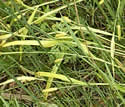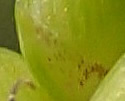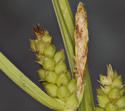Carex granularis (Limestone Meadow Sedge)
| Also known as: | Meadow Sedge, Granular Sedge, Pale Sedge |
|---|---|
| Genus: | Carex |
| Family: | Cyperaceae (Sedge) |
| Life cycle: | perennial |
| Origin: | native |
| Habitat: | part shade, sun; average to moist, open soil; meadows, fens, shores, ditches, clearings, edges of swamps and moist woods |
| Fruiting season: | May - July |
| Plant height: | 6 to 24 inches |
| Wetland Indicator Status: | GP: OBL MW: FACW NCNE: FACW |
| MN county distribution (click map to enlarge): |  |
| National distribution (click map to enlarge): |  |
Pick an image for a larger view. See the glossary for icon descriptions.
Detailed Information
Spikes: 
![[photo of spikes]](/udata/r9ndp23q/se/carex-granularis-t.jpg) Separate staminate (male) and pistillate (female) spikes, with a single staminate spike 3/8 to 1½ inches long at the top of the stem. Below the staminate spike are 2 to 5 cylindric, erect to ascending, all-pistillate spikes each up to 1¼ inches long, the uppermost 1 or 2 stalkless or short-stalked, crowding the staminate spike and may rise slightly above it. Lower pistillate spikes are long-stalked and arise singly from the nodes on the upper half of the stem. Pistillate spikes each have a leaf-like bract at the base of the stalk that usually over-tops the terminal spike, the longest bract up to 6 inches long.
Separate staminate (male) and pistillate (female) spikes, with a single staminate spike 3/8 to 1½ inches long at the top of the stem. Below the staminate spike are 2 to 5 cylindric, erect to ascending, all-pistillate spikes each up to 1¼ inches long, the uppermost 1 or 2 stalkless or short-stalked, crowding the staminate spike and may rise slightly above it. Lower pistillate spikes are long-stalked and arise singly from the nodes on the upper half of the stem. Pistillate spikes each have a leaf-like bract at the base of the stalk that usually over-tops the terminal spike, the longest bract up to 6 inches long.
Leaves and stems: 


![[photo of sheath and ligule, with a reddish-brown tinge]](/udata/r9ndp23q/grass/carex-granularis_0630_194826-t.jpg) Leaves are basal and alternate, stem leaves 1.2 to 5.3 mm wide, often over-topping the flowering stem. Stem leaf sheaths loosely wrap the stem and are papery, translucent whitish, often spotted, streaked or tinged reddish-brown on the front. The ligule (membrane where the leaf joins the sheath) is longer than wide with a narrow band of loose tissue around the edge. Leaves are hairless, M-shaped in cross-section when young, becoming flat, and often covered in a waxy bloom that gives a blue-green or gray-green cast. Basal leaves and leaves of vegetative plants can be much broader than stem leaves, 1cm or more wide.
Leaves are basal and alternate, stem leaves 1.2 to 5.3 mm wide, often over-topping the flowering stem. Stem leaf sheaths loosely wrap the stem and are papery, translucent whitish, often spotted, streaked or tinged reddish-brown on the front. The ligule (membrane where the leaf joins the sheath) is longer than wide with a narrow band of loose tissue around the edge. Leaves are hairless, M-shaped in cross-section when young, becoming flat, and often covered in a waxy bloom that gives a blue-green or gray-green cast. Basal leaves and leaves of vegetative plants can be much broader than stem leaves, 1cm or more wide.
![[photo of basal sheaths]](/udata/r9ndp23q/grass/carex-granularis_0613_174014-t.jpg) Bases are wrapped in a green to brown sheath that is not fibrous. Stems are slender, 3-sided, smooth, mostly erect to ascending; some may elongate up to 24 inches at maturity. Not all plants produce flowering stems. Plants typically form dense clumps.
Bases are wrapped in a green to brown sheath that is not fibrous. Stems are slender, 3-sided, smooth, mostly erect to ascending; some may elongate up to 24 inches at maturity. Not all plants produce flowering stems. Plants typically form dense clumps.
Fruit: 
![[close-up of maturing spike]](/udata/r9ndp23q/grass/carex-granularis-6-t.jpg) Fruit develops in late spring through mid-summer, the pistillate spikes forming clusters of seeds (achenes), each wrapped in a casing (perigynium), subtended by a scale. Pistillate spikes are tightly packed with 10 to 50 fruits, the perigynia mostly ascending.
Fruit develops in late spring through mid-summer, the pistillate spikes forming clusters of seeds (achenes), each wrapped in a casing (perigynium), subtended by a scale. Pistillate spikes are tightly packed with 10 to 50 fruits, the perigynia mostly ascending.
![[photo of perigynia, scale and achene]](/udata/r9ndp23q/grass/carex-granularis-2-t.jpg) Pistillate scales
are egg-shaped to oblong, whitish with a green midrib, often spotted or streaked with reddish-brown, pointed at the tip or the midrib extending to a short awn, and shorter than the perigynia.
Perigynia
are olive to yellowish-green or yellowish-brown at maturity and may be spotted or streaked reddish-brown, 2.2 to 3.1(4) mm long, 1.2 to 1.8(2) mm wide, several-veined, hairless, slightly inflated, generally oval-elliptic to nearly round, rounded at the base with an abrupt taper to a short, toothless beak that may be straight or bent.
Achenes
are 1.8 to 2.3 mm long, 3-sided, urn-shaped.
Pistillate scales
are egg-shaped to oblong, whitish with a green midrib, often spotted or streaked with reddish-brown, pointed at the tip or the midrib extending to a short awn, and shorter than the perigynia.
Perigynia
are olive to yellowish-green or yellowish-brown at maturity and may be spotted or streaked reddish-brown, 2.2 to 3.1(4) mm long, 1.2 to 1.8(2) mm wide, several-veined, hairless, slightly inflated, generally oval-elliptic to nearly round, rounded at the base with an abrupt taper to a short, toothless beak that may be straight or bent.
Achenes
are 1.8 to 2.3 mm long, 3-sided, urn-shaped.
Notes:
Carex granularis is a common sedge of moist, open areas including meadows, fens, ditches, and edges of woods and swamps and tolerates alkaline soils, hence the “limestone” in the common name.
Carex is a large genus, with over 600 species in North America and 150+ in Minnesota alone. They are grouped into sections, the species in each group having common traits. Carex granularis is in the Granulares section; some of its common traits are: clump forming or not, short to long rhizomatous though may be inconspicuously so, basal sheaths not fibrous, leaves M-shaped in cross-section when young, leaves hairless, 3 to 6 spikes, terminal spike all staminate, lateral spikes all pistillate or with a few staminate flowers at the tip (androgynous), lateral spikes sometimes stalked, lowest spike subtended by a long-sheathing leaf-like bract, perigynia hairless, generally oval-elliptic, often dotted or streaked reddish or yellowish, distinctly veined and abruptly short-beaked, achenes 3-sided with 3 stigmas, growing in moist, open areas.
Carex granularis is one of the two members of the Granulares section in Minnesota, the other is Carex crawei. C. granularis is distinguished from other Carex species by the combination of: clump forming, usually densely so, 3 to 6 spikes, terminal spike all staminate, the uppermost 1 or 2 pistillate spikes crowding the staminate spike and may over-top it, perigynia usually 2.2 to 3.1 mm long (occasionally to 4 mm), several-veined, a minute beak that is straight or bent, 3-sided achenes, red-spotted or tinged on sheaths, scales and/or perigynia. It is, however, a rather variable species and features such as perigynia shape, red coloring and prominence of veins may not be consistent. The “spotting” on sheaths, perigynia and scales in particular may look like a large splotch or the brownish tinging seen on other species rather than scattered red dots across the surface, so its usefulness as a diagnostic trait in the field is not entirely clear. Also note that the 1 cm maximum leaf width listed in several references seems understated for basal leaves and vegetative shoots.
C. granularis resembles several other sedges, most notably members of the Griseae section, which have indented veins on mature perigynia where C. granularis veins are raised. It also resembles members of the Laxiflorae section, which have similarly shaped perigynia, especially Carex blanda, which is most often found in shaded woodlands, its perigynia are more tapering at the base, have more veins (best seen when dry) and beaks that are consistently and more strongly bent. C. crawei is most easily differentiated from C. granularis by having a pistillate spike at the base of the stem and the uppermost pistillate spike usually well-separated from the staminate spike, where C. granularis spikes are all in the upper stem and the uppermost 2 or 3 spikes are all crowded at the stem tip.
Native Plant Nurseries, Restoration and Landscaping Services ↓
More photos
 Limestone Meadow Sedge plants
Limestone Meadow Sedge plants Limestone Meadow Sedge in a dense clump
Limestone Meadow Sedge in a dense clump Limestone Meadow Sedge in a looser clump
Limestone Meadow Sedge in a looser clump exceptionally wide basal leaves
exceptionally wide basal leaves reddish-speckled scale?
reddish-speckled scale? single pistillate spike crowding the staminate spike
single pistillate spike crowding the staminate spike
Photos courtesy Peter M. Dziuk taken in Kittson, Marshall and Olmsted counties. Other photos courtesy Steve Eggers.
Comments
Have you seen this plant in Minnesota, or have any other comments about it?
on: 2020-09-08 23:51:21
One of about 10 species of Carex in my yard






